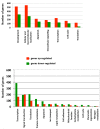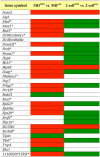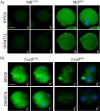Gatekeeper of pluripotency: a common Oct4 transcriptional network operates in mouse eggs and embryonic stem cells
- PMID: 21729306
- PMCID: PMC3154874
- DOI: 10.1186/1471-2164-12-345
Gatekeeper of pluripotency: a common Oct4 transcriptional network operates in mouse eggs and embryonic stem cells
Abstract
Background: Oct4 is a key factor of an expanded transcriptional network (Oct4-TN) that governs pluripotency and self-renewal in embryonic stem cells (ESCs) and in the inner cell mass from which ESCs are derived. A pending question is whether the establishment of the Oct4-TN initiates during oogenesis or after fertilisation. To this regard, recent evidence has shown that Oct4 controls a poorly known Oct4-TN central to the acquisition of the mouse egg developmental competence. The aim of this study was to investigate the identity and extension of this maternal Oct4-TN, as much as whether its presence is circumscribed to the egg or maintained beyond fertilisation.
Results: By comparing the genome-wide transcriptional profile of developmentally competent eggs that express the OCT4 protein to that of developmentally incompetent eggs in which OCT4 is down-regulated, we unveiled a maternal Oct4-TN of 182 genes. Eighty of these transcripts escape post-fertilisation degradation and represent the maternal Oct4-TN inheritance that is passed on to the 2-cell embryo. Most of these 80 genes are expressed in cancer cells and 37 are notable companions of the Oct4 transcriptome in ESCs.
Conclusions: These results provide, for the first time, a developmental link between eggs, early preimplantation embryos and ESCs, indicating that the molecular signature that characterises the ESCs identity is rooted in oogenesis. Also, they contribute a useful resource to further study the mechanisms of Oct4 function and regulation during the maternal-to-embryo transition and to explore the link between the regulation of pluripotency and the acquisition of de-differentiation in cancer cells.
Figures








Similar articles
-
OCT4 and the acquisition of oocyte developmental competence during folliculogenesis.Int J Dev Biol. 2012;56(10-12):853-8. doi: 10.1387/ijdb.120174mz. Int J Dev Biol. 2012. PMID: 23417407 Review.
-
In silico identification of a core regulatory network of OCT4 in human embryonic stem cells using an integrated approach.BMC Genomics. 2009 Jul 15;10:314. doi: 10.1186/1471-2164-10-314. BMC Genomics. 2009. PMID: 19604364 Free PMC article.
-
A novel and critical role for Oct4 as a regulator of the maternal-embryonic transition.PLoS One. 2008;3(12):e4109. doi: 10.1371/journal.pone.0004109. Epub 2008 Dec 31. PLoS One. 2008. PMID: 19129941 Free PMC article.
-
Molecular cloning and expression of Octamer-binding transcription factor (Oct4) in the large yellow croaker, Larimichthys crocea.Gene Expr Patterns. 2018 Jan;27:16-30. doi: 10.1016/j.gep.2017.10.001. Epub 2017 Oct 4. Gene Expr Patterns. 2018. PMID: 28987646
-
Role of Oct4 in maintaining and regaining stem cell pluripotency.Stem Cell Res Ther. 2010 Dec 14;1(5):39. doi: 10.1186/scrt39. Stem Cell Res Ther. 2010. PMID: 21156086 Free PMC article. Review.
Cited by
-
Maternal-zygotic knockout reveals a critical role of Cdx2 in the morula to blastocyst transition.Dev Biol. 2015 Feb 15;398(2):147-52. doi: 10.1016/j.ydbio.2014.12.004. Epub 2014 Dec 13. Dev Biol. 2015. PMID: 25512302 Free PMC article.
-
How the Oocyte Nucleolus Is Turned into a Karyosphere: The Role of Heterochromatin and Structural Proteins.J Dev Biol. 2024 Oct 18;12(4):28. doi: 10.3390/jdb12040028. J Dev Biol. 2024. PMID: 39449320 Free PMC article. Review.
-
Optimization of bovine oocyte cryopreservation: membrane fusion competence and cell death of linoleic acid-in vitro matured oocytes subjected to vitrification.Front Vet Sci. 2025 Jul 4;12:1628947. doi: 10.3389/fvets.2025.1628947. eCollection 2025. Front Vet Sci. 2025. PMID: 40687088 Free PMC article.
-
Heat stress-induced alterations in the expression of genes associated with gonadal integrity of the teleost Puntius sophore.Fish Physiol Biochem. 2019 Aug;45(4):1409-1417. doi: 10.1007/s10695-019-00643-4. Epub 2019 May 29. Fish Physiol Biochem. 2019. PMID: 31144086
-
Acquisition of oocyte competence to develop as an embryo: integrated nuclear and cytoplasmic events.Hum Reprod Update. 2018 May 1;24(3):245-266. doi: 10.1093/humupd/dmx040. Hum Reprod Update. 2018. PMID: 29432538 Free PMC article. Review.
References
-
- Cavaleri F, Scholer H. In: Stem Cells. Lanza R, Gearhart J, Hogan B, Melton D, Pedersen R, Thompson J, West M, editor. Amsterdam: Elsevier Academic Press; 2005. Molecular facets of pluripotency; pp. 27–44.
Publication types
MeSH terms
Substances
LinkOut - more resources
Full Text Sources
Other Literature Sources
Molecular Biology Databases

